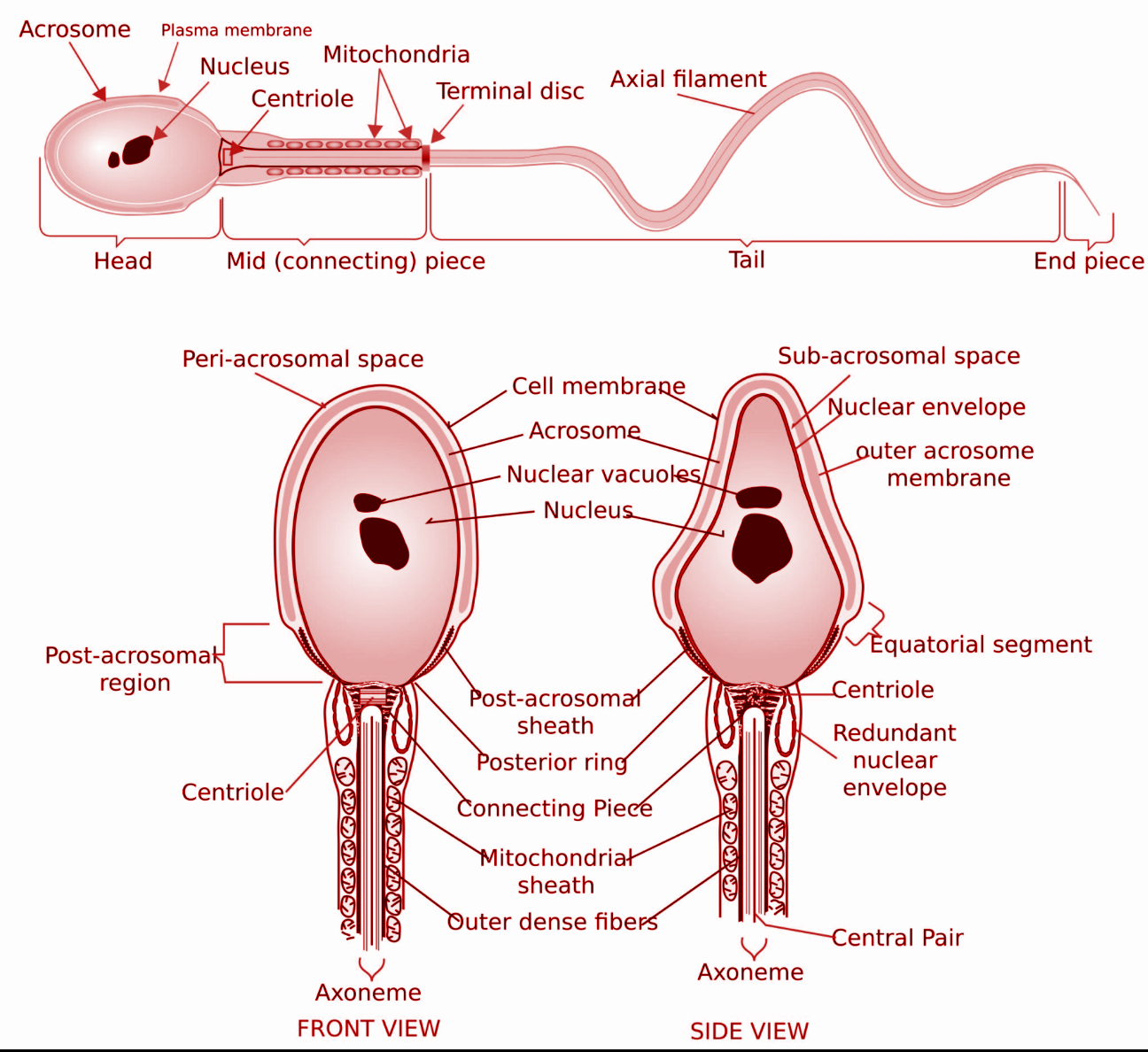
Draw the diagram of the human sperm and label its parts. Describe it in a few sentences.
Answer
480.3k+ views
Hint: The sperm is the male gamete arising from the male reproductive system. It is a microscopic structure, motile in nature, and fertilizes the female gamete, the egg. In mammals, the motile sperm travels with the help of a fluid known as semen.
Complete step by step answer:
- The human sperm can be divided into the head, the neck, the middle piece, and the tail.
- The entire body is enveloped by a plasma membrane.
- The head contains an elongated haploid nucleus that encloses the genetic material. The anterior end of the head is covered with a cap- like structure known as the acrosome.

- The acrosome contains enzymes such as hyaluronidase that help in fertilization of the ovum.
- The middle piece contains mitochondria that are responsible for providing energy for the movement of the tail. This facilitates sperm motility that is essential for fertilization.
- The tail is the longest part and is also called the flagellum. Its wave- like motion propels the sperm forward and aids it in swimming and penetration of the egg.
Additional Information:
- Sperm cells are formed during a process called spermatogenesis. It takes place in the seminiferous tubules of testes in humans.
- The formation of sperm takes place by meiotic division.
- Semen, the fluid required to transport and provide nutrition to the sperm cells is produced in the seminal vesicles, prostate gland, and urethral glands.
- During fertilization, the sperm activates the oocyte and provides the haploid paternal genome and the centriole.
Note:
- Sperm cells cannot divide and have a limited lifespan.
- The human male ejaculates 200-300 million sperm in one coitus. In normal fertility in a healthy human, at least $60\%$ of the sperms must have normal structure and size and at least $40\%$ of them must show rigorous motility.
- Sperm cells can survive inside the female reproductive tract for more than 5 days after coitus.
Complete step by step answer:
- The human sperm can be divided into the head, the neck, the middle piece, and the tail.
- The entire body is enveloped by a plasma membrane.
- The head contains an elongated haploid nucleus that encloses the genetic material. The anterior end of the head is covered with a cap- like structure known as the acrosome.

- The acrosome contains enzymes such as hyaluronidase that help in fertilization of the ovum.
- The middle piece contains mitochondria that are responsible for providing energy for the movement of the tail. This facilitates sperm motility that is essential for fertilization.
- The tail is the longest part and is also called the flagellum. Its wave- like motion propels the sperm forward and aids it in swimming and penetration of the egg.
Additional Information:
- Sperm cells are formed during a process called spermatogenesis. It takes place in the seminiferous tubules of testes in humans.
- The formation of sperm takes place by meiotic division.
- Semen, the fluid required to transport and provide nutrition to the sperm cells is produced in the seminal vesicles, prostate gland, and urethral glands.
- During fertilization, the sperm activates the oocyte and provides the haploid paternal genome and the centriole.
Note:
- Sperm cells cannot divide and have a limited lifespan.
- The human male ejaculates 200-300 million sperm in one coitus. In normal fertility in a healthy human, at least $60\%$ of the sperms must have normal structure and size and at least $40\%$ of them must show rigorous motility.
- Sperm cells can survive inside the female reproductive tract for more than 5 days after coitus.
Recently Updated Pages
Master Class 12 Economics: Engaging Questions & Answers for Success

Master Class 12 Maths: Engaging Questions & Answers for Success

Master Class 12 Biology: Engaging Questions & Answers for Success

Master Class 12 Physics: Engaging Questions & Answers for Success

Master Class 12 Business Studies: Engaging Questions & Answers for Success

Master Class 12 English: Engaging Questions & Answers for Success

Trending doubts
Give simple chemical tests to distinguish between the class 12 chemistry CBSE

How was the Civil Disobedience Movement different from class 12 social science CBSE

India is the secondlargest producer of AJute Bcotton class 12 biology CBSE

Define peptide linkage class 12 chemistry CBSE

How is democracy better than other forms of government class 12 social science CBSE

Draw a labelled sketch of the human eye class 12 physics CBSE




